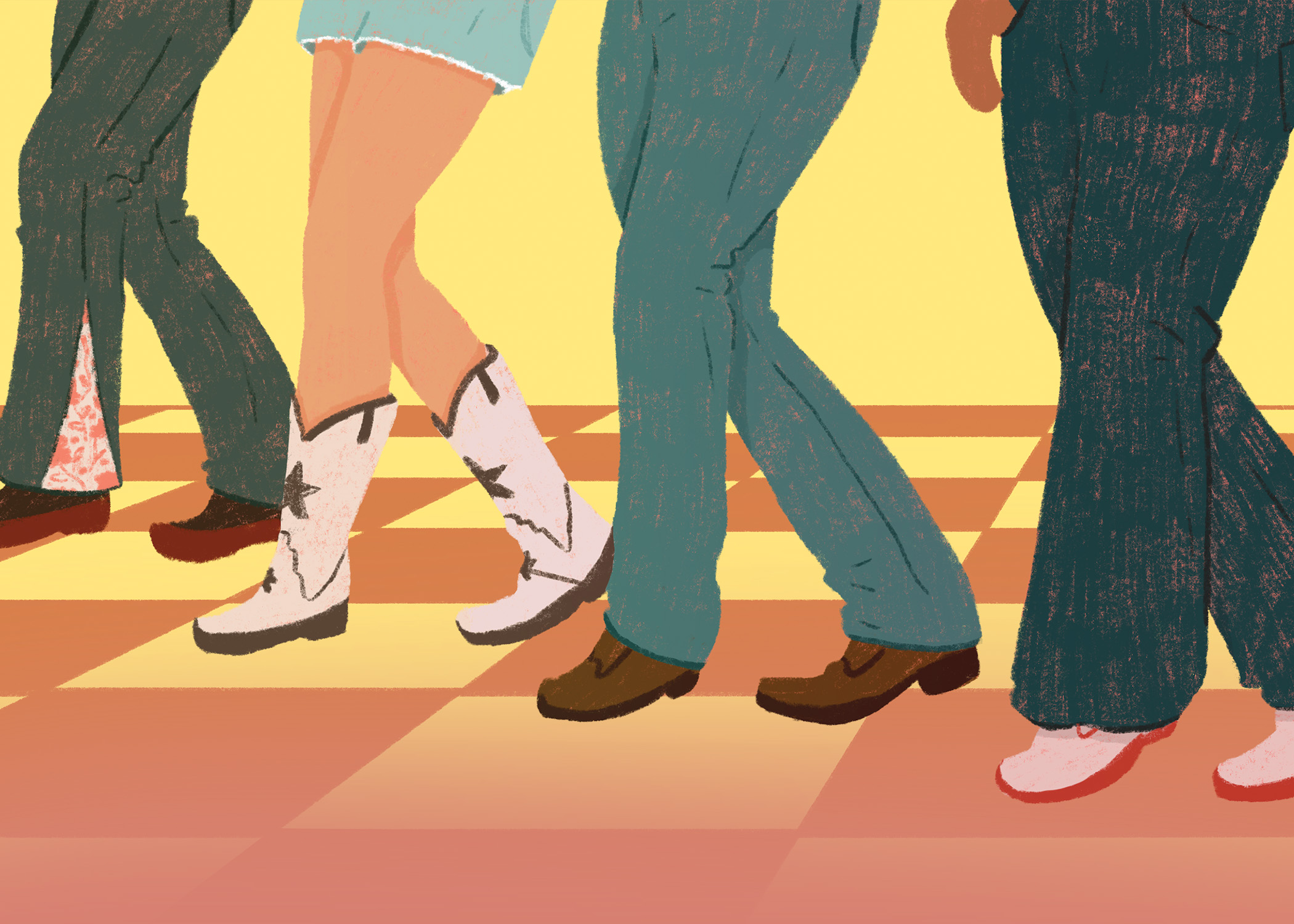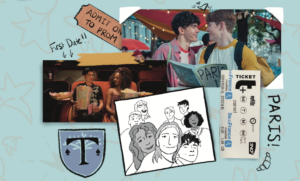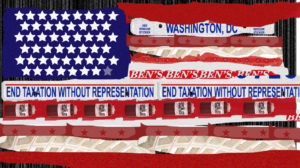Every other Saturday night, volunteers at DC Rawhides turn Eastern Market’s North Hall into a hoedown bursting with queer joy. Cowboy boots, some more authentic than others, stomp in lockstep across a temporary parquet dance floor to “Mambo Shuffle,” “Canadian Stomp,” and crowd favorite, “Shivers.”
Since its founding more than a decade ago, Rawhides has been hosting queer country western dances across the District. Their mission is simple, yet no small feat: preserving the tradition of same-sex country western dancing and creating a space for D.C.’s queer community to come together.
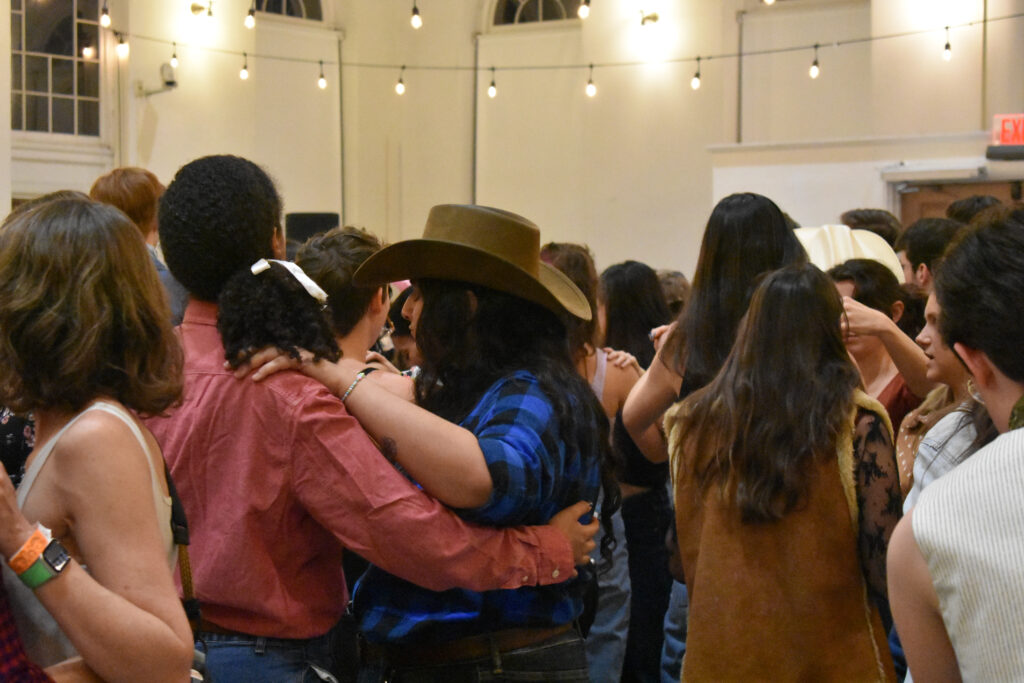
Photo by Izzy Wagener Dancers at DC Rawhides on Saturday, Feb. 8.Photo by Izzy Wagener
For more than 50 years, clubs around the country have been organizing queer country western dances. While they began in the shadows at private clubs under fear of arrest, now they are united by an international association of queer country western dance clubs. Organizations from Pittsburgh to Los Angeles to Munich serve those looking to chassé in an affirming space.
“It’s for people that want to be a part of a community, of a thriving LGBT community that’s active. And it’s very diverse. And I think you don’t get that elsewhere,” Angel Guillory, a longtime dancer and volunteer, said. “Here at Rawhides, you really get a little of everything, and I think that’s so welcoming and so wonderful.”
Rawhides has survived, and thrived, through the shuttering of its first two homes: Remington’s, a gay country western bar that closed in 2014, and Town, a gay dance bar that closed in 2018.
When Remington’s closed, its longtime manager told the Washington Blade, the D.C.-based LGBTQ+ newspaper, that country western dancing was “a fad” that has “run its course.”
Rawhides is proving him wrong.
On Jan. 25 and Feb. 8, the hall reached its capacity of more than 400 people before 10 p.m.—“the dance,” as organizers call it, goes until 11 p.m.
Organizers and dancers pointed to various reasons for the group’s growth and popularity, from word of mouth to social media—Rawhides has more than 90,000 followers on Instagram. Above all, they agreed that the strength and warmth of the community is what keeps people coming back, especially in the wake of mounting attacks on the LGBTQ+ community in the U.S. and across the world.
“In the climate of the world today, people feel attacked and isolated. Rawhides is the one place you can go and just be happy for a night and be safe. Whether you dance or not, just be around people who are really enjoying life at that moment,” Guillory said.
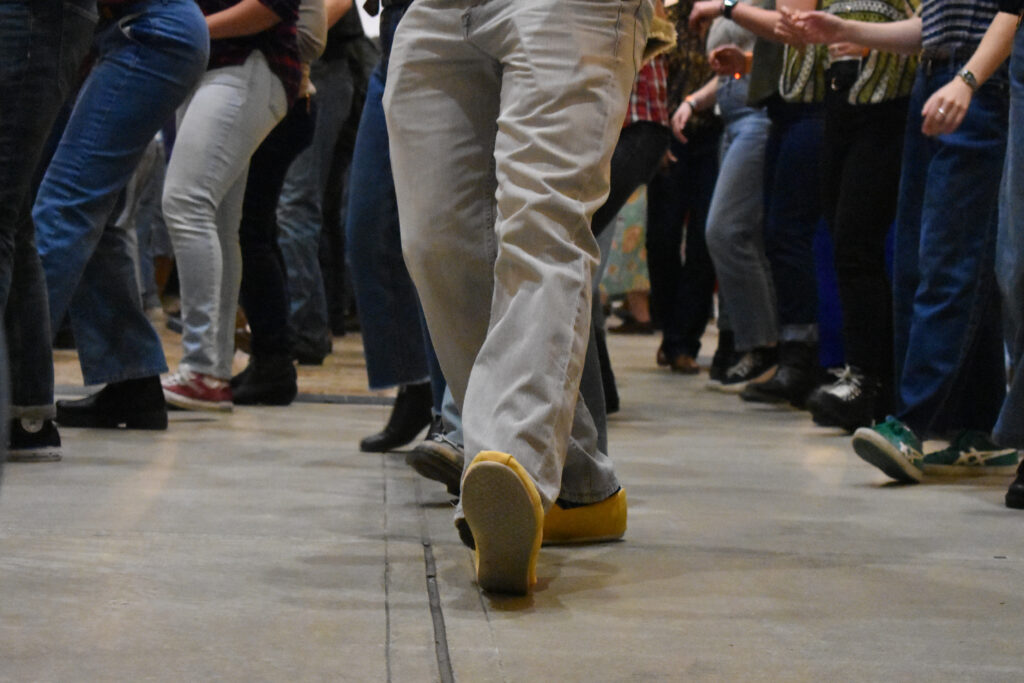 Photo by Izzy Wagener
Photo by Izzy Wagener
Guillory found Rawhides more than a decade ago, and to this day, she has stuck around because of the dance’s supportive atmosphere.
“I was newly out. I was looking for avenues to go out and to meet people in safe spaces and that turned out to be one of them,” Guillory said. “I’ve moved away three times and I think each time what pulls me back here is the community, and part of that is Rawhides. I just can’t find that anywhere else.”
For the first time in its history, Guillory estimates, the crowd at Jan. 25’s dance had more women than men. Unlike many queer spaces in D.C. and elsewhere that tend to be male-dominated, Rawhides draws a remarkably diverse crowd.
The gender-inclusivity of Rawhides also gives women and gender non-conforming people the opportunity to lead on the dance floor. Traditionally, most country western two-step or partner dances feature mixed-gender couples, with men leading and women following.
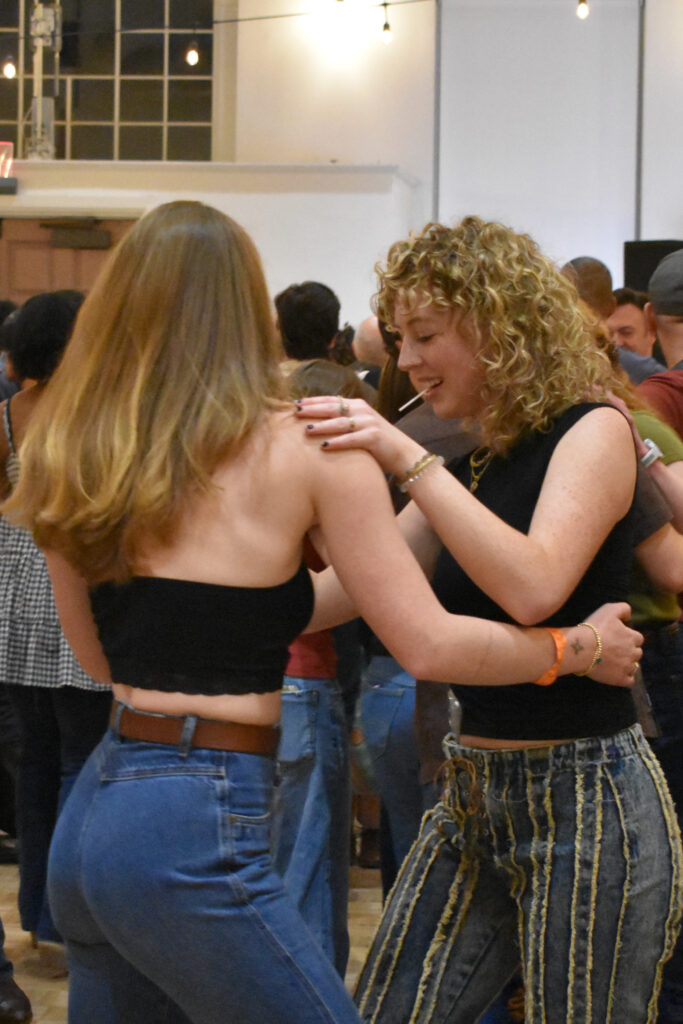 Photo by Yunji Yun
Photo by Yunji Yun
“Everybody dances with everybody. You’re not pigeonholed in one way or another. I’m a woman, but I can lead or follow. It’s just really freeing,” Guillory said.
During a summer out west, Charlotte Correiro (CAS ’24) went dancing at a Colorado country bar with a mixed-gender group of co-workers. There, strict gender roles were enforced, creating a very different experience than at Rawhides.
“I loved this bar. We went a couple of times, but they were very strict about women having to follow and men having to lead, which was crazy,” she said. “I was just following and it was really cool to experience but less cool with a man that I had known for three weeks, you know? If one of the lesbians at Rawhides was, like, ‘Let’s go do that,’ I would be, like, ‘Okay, great!’”
That sense of comfort, openness, and lack of judgement, according to Correiro and Gillory, is what brings participants back time and again. Even people who identify as non-dancers are encouraged to give it a try.
“You can watch people and no one’s gonna judge you. You can also participate as much as you are able, and if you want to try and learn, someone will be willing to help you,” Jaelyn Mitchell, a Rawhides volunteer, said.
The growing crowd of dancers inspires Patrick DiBattista, who has been dancing for more than 20 years, to keep volunteering hours per week to organize, run, set up, and take down the dance along with a team of several dozen volunteers.
“The beautiful mix we have of people and types of people, you can’t beat it,” DiBattista said. “Hopefully it gives us resilience. Hopefully it gives us joy. And hopefully it sustains us, and hopefully it heals us. I’ll say that—hopefully, it heals us.”
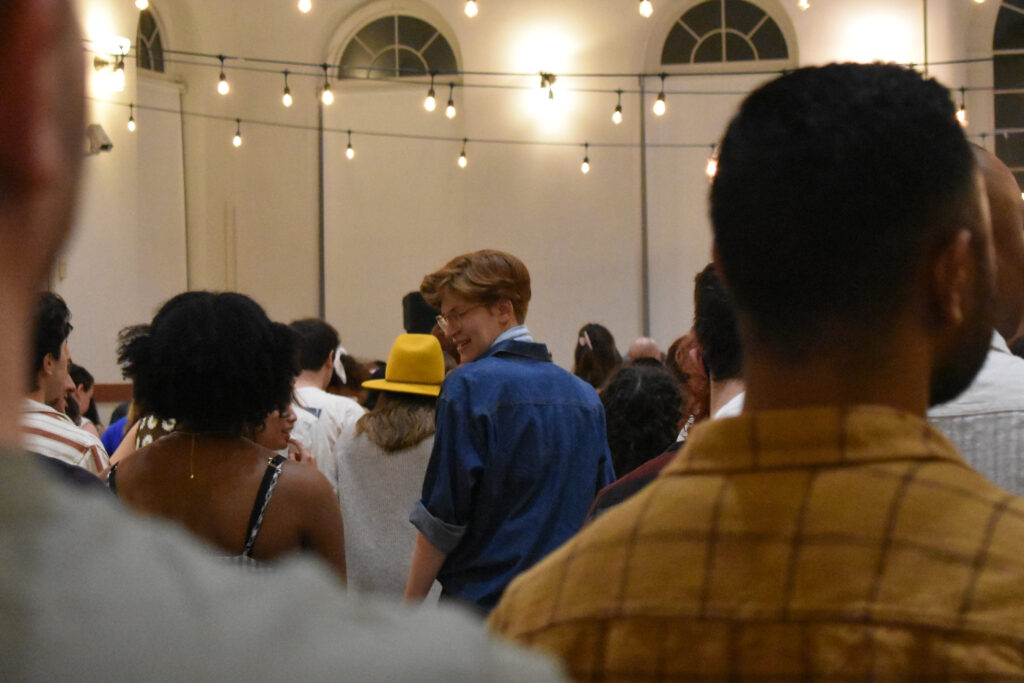 Photo by Yunji Yun
Photo by Yunji Yun
Dancers’ ages range from 21 to over 70—participants need ID to attend. For younger participants watching elder queers move across the dance floor, it is hard not to think about how such a scene would have been impossible or outright illegal in their youth.
“Elder queers are everywhere, which is just huge,” Correiro, who frequents the dance, said. “It made me emotional to see.”
In 1980, a federal court ruled that public high school students have a right to bring same-sex partners to school dances. That same year, two men were kicked out of Disneyland for dancing together, a violation of the park’s strict “male/female” couples-only policy. In 1985, after a long legal battle, Disney changed its policy, giving same-sex couples the right to dance. Same-sex couples in New York City were prohibited from publicly holding hands, dancing, or kissing until the 1970s.
Given this history, organizers are well aware that “the dance” is far more than just a dance to many of its participants.
“When you walk through that door, our goal is to make sure that you are seen. That you are seen as your authentic self and accepted as your authentic self,” DiBattista said. “Not that you just feel welcome, but that you are welcome, and that we communicate that you are welcome.”
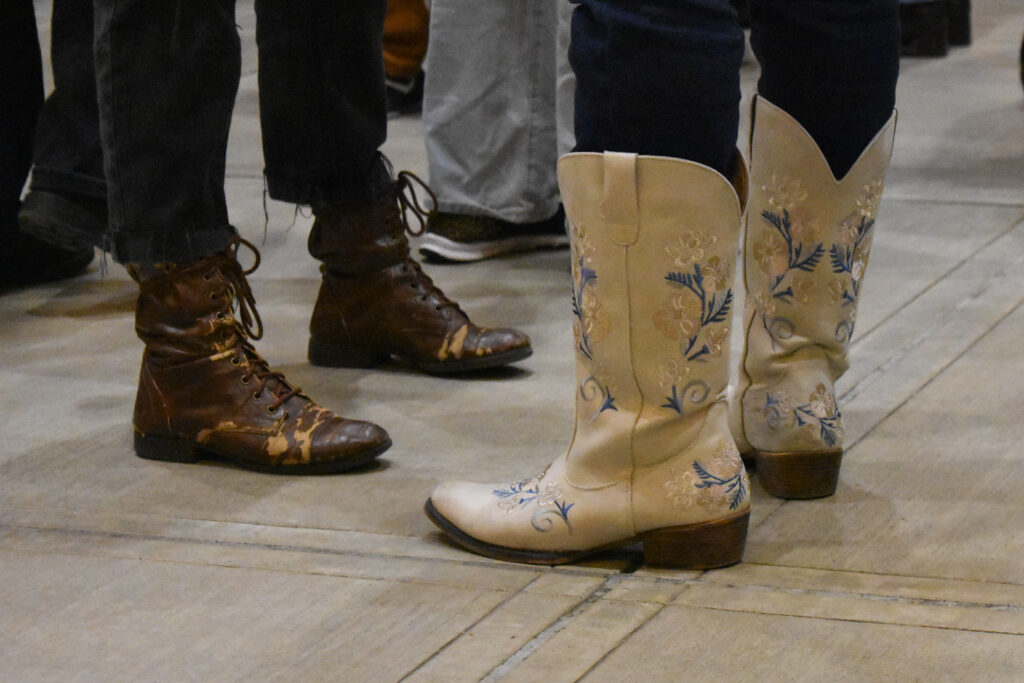 Photo by Yunji Yun
Photo by Yunji Yun
As more people join the dance, DiBattista continues to emphasize that all are welcome—experience, skill, or rhythm are not required.
“It’s a live, changing, evolving, dynamic group of people who are connected and have been connected for a long time. Again, some of the people who dance with us, I’ve danced with them for 20 years. And some of the people who dance with us, I’ve danced with for three months. And each is equally important,” DiBattista said.
D.C. is the gayest “state” (or district!) in the U.S., yet local queer gathering spaces seem to be few and far between. A 2021 study found that more than 14% of D.C. residents identify as LGBTQ+, almost double the next state, Oregon. In a city of well over 1,000 bars, there are less than 30 gay bars, only two of which cater primarily to women and gender non-conforming clientele.
The organizers behind Rawhides have tried to create a diverse, community-oriented, “non-hookup” space for the District’s queer and allied population. Yes, even straight people are welcome.
“I don’t identify as queer, and I know that might turn off people, but there’s no hate. They’re not going to kick you out or anything like that,” Mitchell said. “Also, for people who just don’t know how to dance, the expectation for dance level is like, two left feet and rhythm optional.”
Many in Rawhides are celebrating country western dancing’s rise in popularity among the queer community.
“Beyoncé does country music now! It’s not your mama’s country dancing,” Guillory said. “Rawhides has evolved over time to be more welcoming, and we’re trying to stay current. I mean, we throw the wobble in there and try and include current songs.”
Still, some members worry about the potential commodification of the dance. In the last few years, a new group of queer country dancers has arrived on the scene: Stud Country. A dance collective started in Los Angeles, Stud Country has garnered significant media attention in the last couple of years and become the de-facto face of “gay country dancing.” They now host events in Los Angeles, San Francisco, New York City, and Nashville.
Correiro has mixed feelings about the group, and encourages people who are interested in dancing to explore local options outside of what they find on Instagram.
“That is so fucking awesome, but have you checked the website for the International Association of Gay/Lesbian Country Western Dance Clubs? Because there might be one 20 minutes outside of the city that’s been running for 25 years and they just don’t have such a flashy Instagram presence and the median age is 45,” Correiro said. “I don’t want to be scared of that. And I’m ultimately excited that it’s popping up.”
For Correiro and Guillory, dancing in an explicitly queer space brings a level of comfort that they haven’t felt elsewhere.
“Every time I walk in, I’m happy, and everyone says that. They’re like, ‘Oh man, I’m so glad I’m here. My life just got better. My day just got better,’” Guillory said. “And I’ve gone to dance in other places and it’s not the same.”
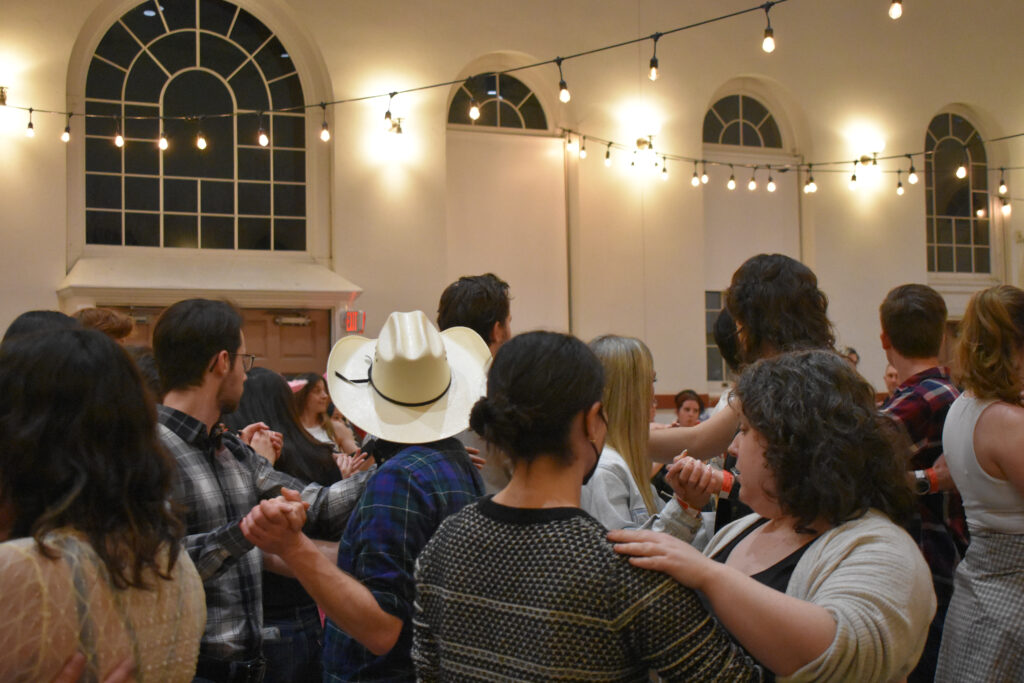 Photo by Izzy Wagener
Photo by Izzy Wagener
Volunteers and organizers are committed to keeping the community going for as long as people are willing to come out and dance.
“The dance belongs to the community,” DiBattista said. “And we’re going to continue to work to ensure that the dance has a home.”


